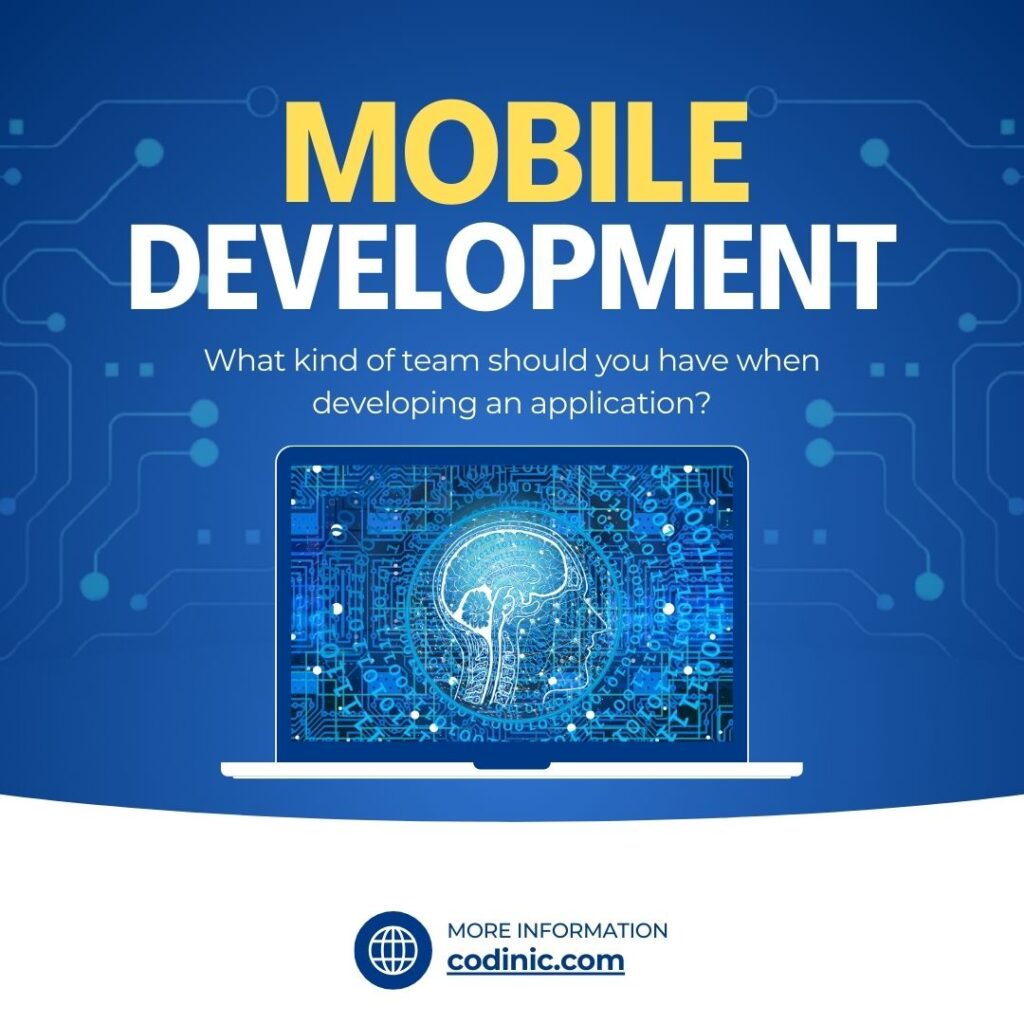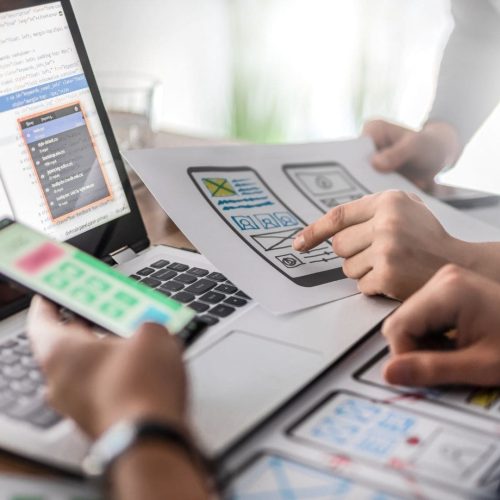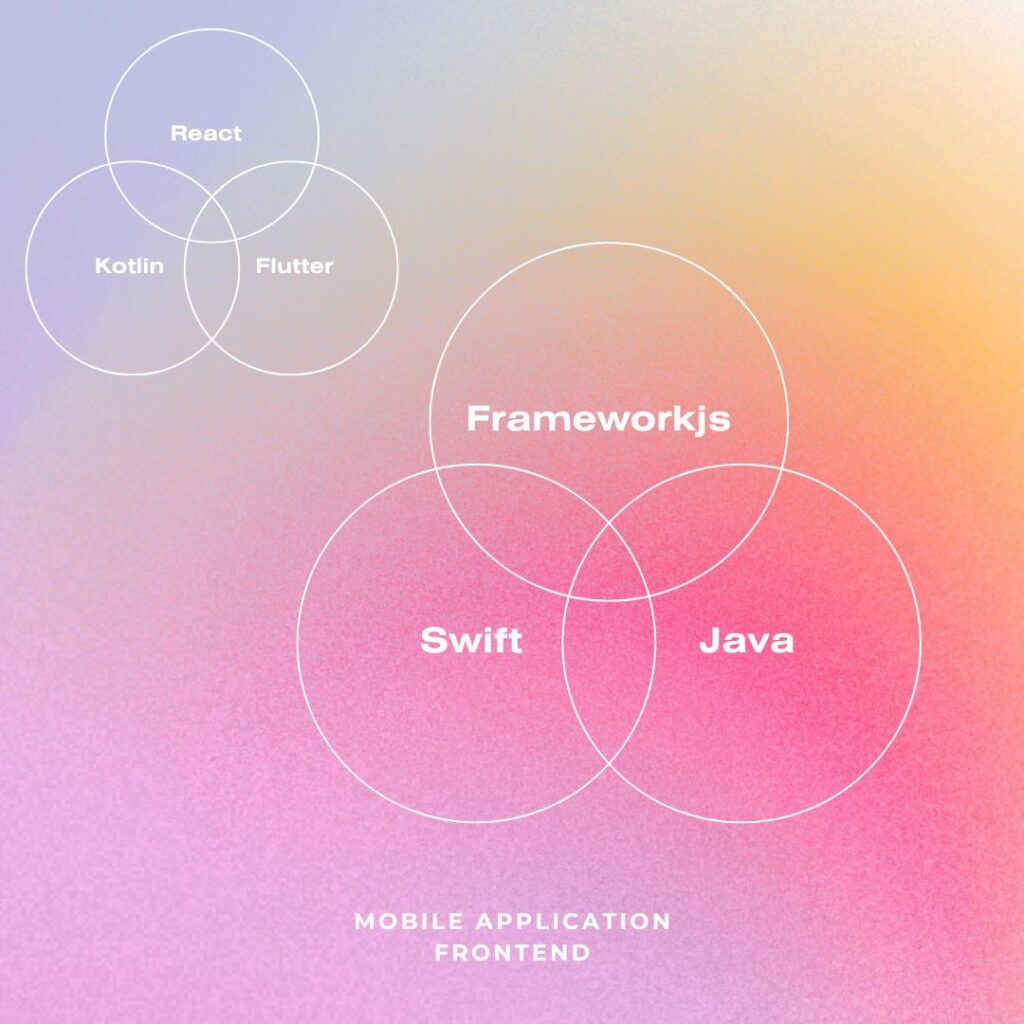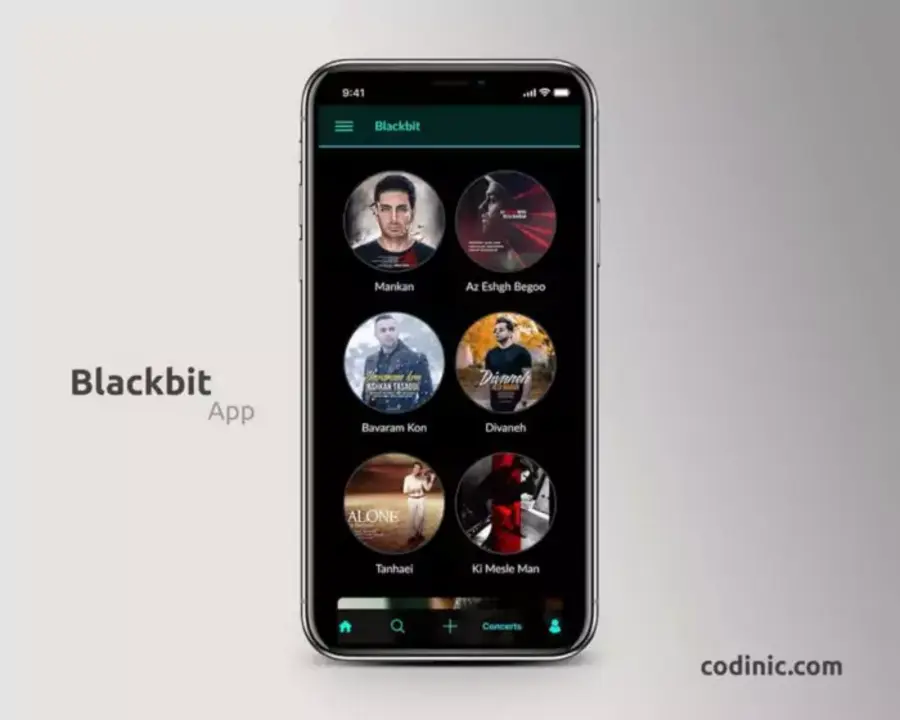Frontend, Backend and Design Together
Frontend, Backend and Design Together requires the alignment of technical knowledge and user experience to develop a successful application. It requires collaboration between multiple disciplines, each contributing a different aspect of the project. The right team ensures that the program works well, meets user needs, scales efficiently and stays on budget and on schedule. A team of diverse people with a variety of skills and perspectives is essential to build a product that meets user needs and delivers exceptional value. In this article, we will explore the key roles and characteristics that should be part of your development team.
Today, the mobile app market is booming and with it comes a growing demand for high-quality, user-friendly apps. To create a successful mobile app, it is essential to pay attention to a few key areas, including design, backend development, frontend development and overall development phases.

How Can Frontend Backend and Design Go Together?
The combination of Frontend Backend and design is critical for developing an effective mobile application. First of all, user experience and aesthetics should be prioritized in the design process. Mobile application design should enable users to easily understand and interact with the application. On the backend side, a solid infrastructure should be created for the functionality and performance of the application. Factors such as database management, API integration and security should be considered in the backend development process. It is essential for a successful mobile application that the frontend and backend teams collaborate to create a user-friendly interface and a strong infrastructure. This combination guarantees efficient operation of the application while increasing user satisfaction.
Key Roles for the Collaboration of Frontend Backend and Design
- Project Manager: The project manager oversees the entire development process, ensuring that the project stays on schedule, within budget and aligned with overall business objectives. They are responsible for coordinating tasks, managing resources and resolving conflicts.
- Software Developers: These people form the backbone of the development team responsible for writing the code that brings the application to life. They must have strong programming skills and a deep understanding of their chosen programming languages and frameworks. These include backend, frontend, etc.
- UI/UX Designers: User experience (UX) and user interface (UI) designers focus on creating intuitive and visually appealing interfaces that enhance the user experience. They work closely with developers to ensure effective translation of design into code.
- Quality Assurance (QA) Engineers: QA engineers test the application throughout the development process to identify and fix bugs. They play a vital role in ensuring the quality and reliability of the end product.
Additional Roles (Evaluate according to Project Needs)
- Business Analyst: The business analyst bridges the gap between the technical team and business stakeholders. They help define requirements, identify use cases and ensure that the application aligns with the company’s strategic goals.
- Database Administrator (DBA): If the application requires a database, a DBA is responsible for designing, implementing and maintaining the database infrastructure.
- Security Specialist: In today’s digital age, security is a top priority. A security expert can help identify potential vulnerabilities and implement measures to protect the application and user data.
- DevOps Engineer: DevOps engineers focus on automating the software delivery process and improving collaboration between development and operations teams. They can help facilitate the deployment and maintenance of the application.
Team Dynamics and Characteristics
- Collaboration: A successful development team creates a collaborative environment where team members work together to achieve common goals.
- Communication: Effective communication is essential to ensure that everyone is on the same page and that potential issues are addressed promptly.
- Problem Solving: The ability to think critically and solve problems creatively is a valuable asset for any development team.
- Adaptability: The software development environment is constantly evolving. A team that can adapt to new technologies and trends will be better positioned for success.
- Passion: A genuine passion for technology and a desire to create innovative solutions can drive a team to achieve great things.
Mobile Application Design
Design is one of the most critical aspects of mobile app development because it directly affects the user experience (UX) and user interface (UI). A well-designed app is not only visually appealing, but also intuitive, easy to navigate and responsive.
UI/UX designers need to be familiar with mobile app design tools like Figma and Zeplin to create seamless and visually appealing user experiences. Understanding design principles such as user flows, interaction design, and responsive layouts helps designers create visual apps that meet user needs. Figma, a collaborative design tool, allows designers to create interactive prototypes, collect feedback and iterate quickly, simplifying the design process.
Zeplin, on the other hand, provides developers with detailed design specifications and resources, bridging the gap between design and development and ensuring proper design implementation. Together, these tools increase collaboration, efficiency and the overall quality of the mobile app’s user interface and experience.

Basic elements of mobile application design:
- User Experience (UX): UX design focuses on how users interact with the app. The goal is to ensure that users can easily perform their tasks without confusion or frustration. To achieve this, designers should consider user flows, information architecture and usability testing.
- User Interface (UI): UI design is concerned with the visual elements of the app, including buttons, menus, fonts, colors and icons. The design should be consistent, aesthetically pleasing and in line with the app’s brand.
- Responsiveness: Mobile apps should be responsive to different screen sizes, including various smartphones and tablets. The design should automatically adjust and remain functional across devices.
- Accessibility: Accessibility considerations are important to ensure that the app can be used by people with disabilities. This includes features such as screen readers, adjustable text sizes and color contrast.
Tips for mobile app design:
- Keep it simple and intuitive.
- Prioritize usability testing throughout the design process.
- Focus on touch gestures and mobile-specific interactions.
- Ensure visual elements are optimized for mobile screen resolutions.
- Ensure fast load times by optimizing assets such as images and videos.
Mobile Application Frontend
The frontend of the mobile app is what users interact with directly. This includes everything the user sees and experiences on their mobile device, such as the app’s layout, animations and overall responsiveness. The frontend is developed using technologies that can be native or hybrid.
React Native, Flutter, Kotlin, Java, Swift and Frameworkjs are essential tools for frontend mobile app development, each offering unique strengths for creating engaging and performant user interfaces. React Native and Flutter are popular cross-platform frameworks that allow developers to build apps for iOS and Android using a single code base, reducing development time and costs.
Kotlin and Java are the primary languages for Android development; Kotlin offers a more modern and concise syntax, while Java continues to be widely used for its robustness. Swift is the dominant language for iOS development, known for its performance and deep integration with the Apple ecosystem. Frameworkjs is a powerful tool for building hybrid applications, providing a framework that combines native-like experiences with web technologies. Together, these tools provide flexibility and efficiency across platforms and the ability to deliver seamless, responsive mobile applications.
Basic technologies for frontend development:
- Native Development: This involves building apps specifically for a platform such as iOS or Android. Native apps are developed using platform-specific languages such as Swift (iOS) or Kotlin (Android). These apps tend to have higher performance and better access to platform features.
- Hybrid Development: Hybrid applications are built using web technologies (HTML, CSS, JavaScript) and then wrapped in a native shell to run on multiple platforms. Tools like React Native and Flutter are popular frameworks for hybrid development. Hybrid applications can save development time and cost but can have some performance disadvantages.

Frontend development best practices:
- Optimize performance to minimize lags or delays.
- Focus on creating fluid and engaging animations.
- Ensure a responsive and consistent design across multiple devices and screen sizes.
- Test the app regularly on real devices to ensure the app works as expected.
- Integrate appropriate error handling and validation of user inputs to prevent crashes or unexpected behavior.
Mobile Application Backend
The backend is the part of the application that users don’t see but is critical to the functionality of the application. It is responsible for managing data, server-side logic and communication between the app and the server. The backend enables functionalities such as user authentication, data storage, push notifications and in-app messaging.
A robust mobile app backend that leverages technologies such as PHP, Node.js, .NET Core and databases like MongoDB, SQL and PostgreSQL plays a vital role in improving the efficiency of a development team. These technologies provide the foundation for data management, user authentication, server-side logic and API communication.
For example, Node.js enables high-speed and scalable server-side applications, while PHP provides flexibility in web integration. MongoDB supports efficient management of large datasets with its NoSQL structure, while SQL and PostgreSQL provide powerful relational database management. Together, these backend technologies provide seamless data flow, scalability and faster development cycles, enabling the team to deliver reliable and performant mobile applications.
Backend basic components:
- Server: The server hosts the logic of the application and provides services such as authentication, data management and push notifications. Cloud platforms such as AWS, Google Cloud and Microsoft Azure are often used to host the backend infrastructure.
- Database: Mobile apps typically rely on databases to store and manage user data, app settings and other critical information. Common databases used for mobile app backends include MySQL, MongoDB and Firebase.
- APIs (Application Programming Interfaces): APIs enable the front end of the mobile app to communicate with the backend. RESTful APIs or GraphQL are often used to enable this communication, making it possible for the app to send data to the server and receive a response in return.
- Authentication: A robust authentication system ensures that user data is protected. OAuth, JWT (JSON Web Tokens) and Firebase Authentication are popular solutions for managing secure logins.
Backend development best practices:
- Prioritize security measures such as data encryption, secure APIs and strong authentication methods.
- Optimize database queries and server performance to reduce load times and increase efficiency.
- Set up regular data backups and implement disaster recovery plans.
- Monitor server performance and application utilization for potential problems.
Key Considerations When Developing a Mobile Application
When developing a mobile app, there are several important considerations that should guide the process to ensure success. First, understanding the target audience is essential. The design, features and functionality of the app should align with user preferences, behaviors and needs. Technology knowledge is equally important because choosing the right development stack, be it React Native for cross-platform applications or native languages like Swift or Kotlin, can impact performance, scalability and user experience.
Team planning is essential for effective development, with clear roles for developers, designers, testers and project managers to streamline workflows and meet deadlines. Paying close attention to these factors helps create a functional, user-centered app that stands out in the market.
Several factors need to be considered during mobile app development to ensure success:
- Performance Optimization: Mobile apps should be fast and responsive. Performance optimizations such as caching, image compression and minimizing the use of external resources are important to reduce load times.
- Security: Mobile apps should be designed with security in mind. Protect user data by following best practices in encryption, secure storage and secure coding.
- Platform Compatibility: Decide whether to build a native or cross-platform app based on your user base and development resources. If your app needs to work on both iOS and Android, hybrid frameworks can reduce development time and costs.
- Offline Functionality: Think about how the app will work without an internet connection. Offering offline capabilities or local storage for data can significantly improve the user experience.
- User Feedback and Testing: Regular testing and collecting user feedback helps to identify issues early and improve the overall quality of the app. Beta testing and continuous updates based on feedback ensures that the app evolves to meet user expectations.
Mobile Application Development Stages
Mobile app development usually follows a structured process divided into key stages:
- Ideation and Research
Before development begins, you need to have a clear idea of the app’s purpose and target audience. Research competitors, define the problem your app will solve and outline key features. At this stage, create a product vision and goals to guide the project. - Planning and Prototyping
Create a project plan including timelines, resources and costs. At this stage, you will also develop wireframes and prototypes that visually represent the layout and flow of the app. This is crucial to validate the app concept and gather early feedback. - Design
The design phase involves creating the user interface and experience of the app. The focus is on developing an intuitive and visually appealing design that resonates with users. This phase includes creating wireframes, high-quality mock-ups and interactive prototypes. - Development
Development is divided into frontend and backend tasks. Frontend developers build the user-facing part of the application, while backend developers manage the server logic, databases and APIs. Both teams work closely to ensure seamless integration. - Testing
Testing is critical to identify bugs, performance issues and usability problems. Quality Assurance (QA) teams test the app on a variety of devices, screen sizes and operating systems. They perform both manual and automated testing to ensure the app meets all requirements. - Launching
Once testing is complete, the app is ready to be published. The launch process involves submitting the app to the Apple App Store and Google Play Store. Each platform has specific requirements and guidelines that must be followed. - Post Launch Support and Maintenance
Once the app is launched, ongoing support is required to fix bugs, add new features, and ensure that the app stays compatible with the latest operating system updates. Monitoring user feedback and app performance helps guide future improvements.
To summarize:
Building a successful app requires a multi-disciplinary team where each member brings specialized knowledge and skills. The right mix of talent ensures that all aspects of the app, from design and functionality to security and scalability, are handled efficiently. Building a team that includes product management, UX/UI design, development(frontend and backend), QA, DevOps and security ensures that the application not only meets user needs, but is also reliable, scalable and secure. Whether you are building a small startup app or a large enterprise solution, having the right team is essential for success.



Pingback: Web Design: Importance & Benefits for Your Business - Codinic
Pingback: What is Debugging? The Best Debugging Methods - Codinic